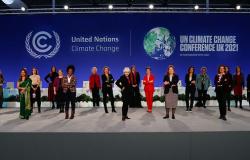The 100 Billion Dollar Question: COP26 Glasgow and Climate Finance

Ayse Kaya and Olivia Stoetzer, accredited COP26 observers, summarise the summit and highlight the progress and tensions that led to its climate finance outcomes.
COP26 in Glasgow, which ran from November 1 to the evening of November 13 (a day later than originally planned), took on the challenge of coming from the highs of the Paris Agreement to the less thrilling task of figuring out the details for the implementation of Paris. COP stands for Conference of the Parties of the UNFCCC (United Nations Framework Convention on Climate Change). One of the central topics in Glasgow was climate finance (based on Article 9 of the Paris Agreement): public and private funds flowing from developed countries to developing countries toward mitigation, i.e. lower emissions and decarbonizing economies, and adaptation, namely building resilience toward the impact of climate change.
Indeed, climate finance has been publicized and politicized since the 2009 COP in Copenhagen, when the developed countries pledged to mobilize 100 billion USD annually by 2020. There are disputes regarding the extent to which this goal has been missed, but the bottom line is it has been (1). Ahead of COP26, the COP Presidency released a Climate Finance Delivery Plan which marked the importance of the issue and noted that “developed countries will make significant progress towards the US $100 billion goal in 2022 and express confidence that it would be met by 2023.” Without adequate finance for climate change, the less well-resourced countries argue, they cannot transition to low carbon economies (finance for mitigation) and adapt to negative repercussions of climate change (adaptation funding). They additionally argue for financing for “loss and damage”, i.e. repercussions of climate change to which they are longer to adapt.
Climate finance was a hold-up issue during Glasgow--it contributed to the prolonged negotiations. So what has been so divisive about climate finance? And, has there been any silver lining from COP26 on this topic? In answering these questions, we draw from our observations of the meetings in Glasgow (as accredited observers). COP26 delivered - unsurprisingly -major compromises on this issue. In return for continued commitment to 100 billion USD, including more finance for adaptation, less developed countries had to abandon some of their priorities for the agreement, including the pursuit of a single definition of climate finance.
Background
The UNFCCC was established in 1992 with the goal of strengthening the global response to climate change, and the annual COPs remain its highest decision-making body. Two major treaties have since been signed under the auspices of the UNFCCC: the Kyoto Protocol in 1997 and the Paris Agreement in 2015. The CMA is the body for the Parties of the Kyoto Protocol and the CPA is the body for the Parties of the Paris Agreement. COP26 saw references to and negotiations by members of both the CMA and CPA.
Since the establishment of the UNFCCC, several bodies have been constructed to exclusively work on climate finance. The Standing Committee on Finance (SCF) was established in 2010 at COP16 to assist the Financial Mechanism of the Convention. The SCF is responsible for helping to coordinate the delivery of climate finance to developing country parties and the mobilization of financial resources. The work program on long-term climate finance (LTF) was launched in 2011 at COP17. Developing countries have fought for the extension of LTF since its mandated end in 2013. The LTF has been tasked with compiling reports from developed countries on their climate finance pledges, along with holding workshops and ministerial dialogues. Though both the SCF and LTF play significant roles, we heard developed economies emphasizing the mandate of LTF being over during the negotiations and wanting to refer key matters, such as the definition of climate finance, to the more formal body of SCF. In essence, then, there is forum preference and shopping for that preference within the UNFCCC.
How to Define Climate Finance
One of the main discussions on climate finance during COP26 revolved around how to define climate finance. On one hand, developed countries, such as the USA and Canada, argue that existing “bottom-up” definitions, i.e. each country having its own definition of climate finance flows, is adequate. On the other hand, less developed countries would like to settle on a single multilateral definition of climate finance, through which all flows could be tracked. Developed countries stressed the need to use Paris language, which emphasizes a bottom-up approach, therefore supporting individual definitions. A multilateral definition would instead signify a “universal” approach as one representative put it.
We also observed arguments on who should define “climate finance” and what bodies have the legal power to make such decisions. The developed countries’ desire for the SCF to handle the issue of defining climate finance was ultimately reflected in the relevant texts from Glasgow: Paragraph 12 of the final text on long-term finance “[r]equests the [SCF] to continue its work on definitions of climate finance, taking into account the submissions received from Parties on this matter, with a view to providing input for consideration by the Conference of the Parties at its twenty seventh session (November 2022).” However, this statement also meets the desire of developing countries to continue discussions on defining climate finance.

Beyond being an issue of transparency and accountability (e.g. countries disagree on whether one can track climate finance without a single multilateral definition), the definitional disagreements also reflect underlying differences in a starting premise across different countries. Such divergences include how much of the funds should be public (i.e. financed by governments) versus supplied by the private sector. What we heard in COP26 mirrored the general approaches you hear in the economic development realm in the sense that advanced economies, in general, and the Americans, particularly though not exclusively, see the private realm playing a critical role. At a stocktaking plenary, John Kerry, U.S. Special Presidential Envoy for Climate, reiterated the United States’ commitment to contributing to the $100 billion goal, but also emphasized the need to not limit the origin of finance to allow countries to meet the goal, alluding to the role of private finance. On one hand, there is no way to generate enough climate finance without private sector involvement, as much more than $100 billion is needed. And, in an ideal world, public funds from particular multilateral institutions should catalyze private finance. On the other hand, there is a market failure in terms of private flows for climate finance: markets won’t allocate funds to green sectors unless profitability can be boosted or even ensured (with government involvement, such as through subsidies for green energy). So whether it constitutes actual flows or whether it catalyzes those flows, public involvement matters significantly.
Another key issue regarding defining climate finance concerns how much of it should be in grants versus loans. International aid is rarely just grants, it also includes loans that countries eventually need to pay back (though for many countries these loans tend to be at rates more favorable than the market rate). Naturally, the recipients wish for as much of a grant component as possible. In contrast, the donors expect to see “results”, how the funds are actually utilized and whether they are reaching their targeted goals, and of course loans are paid back. This last fact also means creditworthy recipients tend to receive more loans than the less creditworthy but needy. Despite this general preference for loans, a number of donors were willing to boost the Adaptation Fund, which runs on donor replenishments. To be sure, developing countries do not like the notion of “donations” for adaptation, as they believe the funds are needed in the first place given the “historical responsibility” for emissions.
The Silver Lining?: Adaptation Finance
A key issue regarding climate finance coming into Glasgow has been the disproportionate amount of finance going into mitigation over adaptation. Glasgow witnessed an increase in country commitments to the Adaptation Fund. The Adaptation Fund, established in 2007, provides funding to developing countries to pursue projects and programs that would assist adaptation efforts. During COP26 negotiations, the Fund was lauded for efforts to include local communities and for its effective projects. And, for the first time, the United States and Canada pledged contributions to the Fund, 50 million USD and 8.1 million USD respectively.
Throughout the negotiations, we also observed continuous calls for the increase in adaptation finance from developing countries. Some developed countries want finance to predominantly go towards mitigation efforts, which would have global benefits in reaching the Paris Agreement’s goal of limiting warming to 1.5 degree Celsius (Article 2 of Paris). Conversely, some developing countries urgently need assistance for adaptation efforts, which inevitably have more local impacts. Pre-Glasgow, OECD estimated that mitigation finance has accounted for around two thirds of total climate funding.
The 11/13/2021 text on Long-term Finance, the last one produced at the conference, both celebrates the contributions made for adaptation and also laments the lack of adequate progress, nodding to both sides’ perspectives. It notes “the recent pledges made to the Adaptation Fund (totalling USD 351.6 million) and to the Least Developed Countries Fund (totalling USD 605.3 million)” and also “acknowledges that some developed country Parties have already doubled their provision of adaptation finance and requests other developed country Parties to significantly increase their provision of adaptation finance”. It adds that these countries could “consider ‘doubling’ adaptation finance.” Earlier in the negotiations, developed country parties opposed the need for embracing a doubling target, while developing countries pressed to replace the doubling target with “quadrupling” or “reaching parity”.
The language of the agreement also presents a compromise. The appropriate verbs were discussed at great length during the negotiations. For instance, a verb like “request” can be resisted by some representations, while preferred by others, as it is seen to signal greater commitment. In this context, the aforementioned “consider ‘doubling’” is a watered down version of what some Parties wanted. This set the text of the Glasgow COP26 agreement (in paragraph 18), which also “urges”, as opposed to requests, to double adaptation finance from 2019-2025.
Given developed country representatives were keen -- in negotiation room after negotiation room -- to highlight how much their state/union had contributed to adaptation finance, Glasgow onward, we can expect the ratio of adaptation finance to mitigation finance to continue improving. There seems to be a race for prestige in this realm, instigated in part by the leadership in Glasgow and in part by needing to bridge the trust gap between well- and less-resourced countries. If the initial hope of the Paris Agreement was to use the power of “naming and shaming” to inspire higher ambition, it seems to be working in terms of financing the Adaptation Fund.
Timeframe & A New Collective Goal
However, unlike progress on this ground, Glasgow failed to produce a new quantifiable collective goal for climate finance, namely a new joint target for climate finance flows. During the negotiations, developing parties pushed for this goal. Instead, the negotiations concluded with the decision to convene a “work programme”, from 2022 to 2024, to chart out a new quantified goal by the Parties to the Paris Agreement. Although some representatives during the negotiations pushed for a “working group” as opposed to a programme, which they found less concrete and hence less promising, there were assurances that the programme would lay the groundwork for the establishment of the new goal. Relatedly, in negotiations we observed, developing countries pushed for the missed 100 billion dollar promise to be fulfilled as soon as possible, many naming 2023 as a target. Though developed countries recognized that this target was missed, they emphasize the role of private finance in reaching the goal, which received pushback from developing countries. Paragraph 7 of the final long-term climate finance text states that “developed countries reaffirm the continuation of their existing collective mobilization goal through 2025 in the context of meaningful mitigation action and transparency on implementation.”
Why So Divisive
Surely, distributional issues tend to be contentious, but what makes climate finance even more challenging? One issue is the domestic constraints advanced economies face: the deals they promise have to be ratified by domestic veto players, such as the US Congress, and if they cannot be ratified, they should not be promised. Democratic budget cycles are also not conducive to long-term planning. This affects “predictability” of finance for the developing countries, which they emphasize.
Another issue lies with the overall architecture of climate finance: it is fragmented (like the rest of the governance of climate finance) over a number of different multilateral institutions, the Global Environmental Facility and the Global Climate Fund being two examples. This means that when tracking climate finance one has to consider all these institutions (and not double count), but also that there is room for forum-shopping thanks to this fragmentation: countries can pick and choose through which platform to extend the funds.
There are also fundamental differences in approach. For instance, Americans are not malleable to finance on loss and damage. The Europeans, in contrast, are more open to bolstering the role of loss and damage in Glasgow and onwards. In addition, developed countries want to ensure that funding is being used responsibly and directly, emphasizing the need for “climate rationale.” Developing countries, however, want the flexibility to apply the funds where they deem most useful. Differences in starting premises and different political cultural contexts affect the kind and magnitude of flows down the road.
How to Move Forward
Clearer, easily-accessible data is necessary. Since there will likely continue to be definitions and not a single definition of climate finance, a key task is to generate a new central data collection mechanism. This mechanism could oversee all national contributions while revealing the varied definitions. Countries should be using this data portal to report all their contributions for climate finance in a detailed and timely manner – for instance grant versus loan and why it is additional and new financing, as opposed to a diversion of extant aid flows. Since existing counts have been questioned, starting anew with more transparent reporting can be an ingredient in rebuilding the trust on this issue. This central data portal should include information not just from senders of flows but also recipients, so that matching can occur to avoid any discrepancies. Concrete steps such as this are needed with urgency to fulfill the gap in the 100 billion dollar goal through 2025 as a first step and then meet Glasgow’s call of going beyond it per year. COP President Alok Sharma repeatedly urged countries to “come armed with the currency of compromise” going into the final days of negotiations. Though there may have been compromises in the negotiation room, there was not enough to ensure greater clarity for climate finance going forward.
Ayse Kaya is Associate Professor of Political Science at Swarthmore College, Swarthmore, PA.
Olivia Stoetzer, class of 2023, is a current student at Swarthmore College studying Political Science and Environmental Studies.
Image: Scottish Government via Flickr (CC BY 2.0)
Image 2: Authors' own
Notes
(1) https://www.oxfam.org.uk/media/press-releases/poorer-nations-expected-to-face-up-to-55-billion-shortfall-in-climate-finance/;https://www.oecd.org/environment/climate-finance-provided-and-mobilised-by-developed-countries-aggregate-trends-updated-with-2019-data-03590fb7-en.htm; https://www.bloomberg.com/news/articles/2020-11-06/rich-countries-are-missing-the-100-billion-climate-finance-goal


